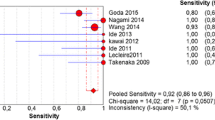Abstract
Background
Lugol chromoendoscopy has been conventionally used for the detection and delineation of esophageal squamous cell carcinoma (SCC). However, the boundaries of some lesions are unclear even with Lugol chromoendoscopy, and there is a risk of residual lesions or over-excision. This study aimed to evaluate the utility of narrow-band imaging (NBI) for the delineation of esophageal SCC in endoscopic resection.
Methods
Among 367 esophageal SCCs endoscopically resected between January and December 2019 at our institute, this retrospective study included consecutive lesions, which were first marked with NBI, followed by Lugol chromoendoscopy. The proportion of residual cancer, which was defined as histologically proven cancer confirmed adjacent to the scar within 1 year after endoscopic resection, was evaluated. To evaluate whether the marks added by Lugol chromoendoscopy after NBI marking were more reliable, we evaluated the presence of cancer in the iodine-unstained area outside the NBI-determined marks, i.e., the cancerous area missed by NBI. The presence of cancer in the iodine-stained areas inside the NBI-determined marks, i.e., the cancerous area missed by Lugol, was also evaluated. These were compared to assess the risk of residual cancer in endoscopic resection with NBI and Lugol chromoendoscopy.
Results
Among 304 lesions, 2 (0.7%) residual cancers were detected. The cancerous area missed by NBI and the cancerous area missed by Lugol were identified in 18 (6%) and 43 (14%) lesions, respectively (P = 0.001).
Conclusions
NBI might be acceptable for delineating the extent of esophageal SCCs that are difficult to delineate with Lugol chromoendoscopy.





Similar content being viewed by others
References
Bray F, Ferlay J, Soerjomataram I, et al. Global cancer statistics 2018: GLOBOCAN estimates of incidence and mortality worldwide for 36 cancers in 185 countries. CA Cancer J Clin. 2018;68:394–424.
Ishihara R, Tanaka H, Iishi H, et al. Long-term outcome of esophageal mucosal squamous cell carcinoma without lymphovascular involvement after endoscopic resection. Cancer. 2008;112:2166–72.
Fujishiro M, Yahagi N, Kakushima N, et al. Endoscopic submucosal dissection of esophageal squamous cell neoplasms. Clin Gastroenterol Hepatol. 2006;4:688–94.
Takahashi H, Arimura Y, Masao H, et al. Endoscopic submucosal dissection is superior to conventional endoscopic resection as a curative treatment for early squamous cell carcinoma of the esophagus (with video). Gastrointest Endosc. 2010;72(255–64):264.e1-2.
Yamashina T, Ishihara R, Nagai K, et al. Long-term outcome and metastatic risk after endoscopic resection of superficial esophageal squamous cell carcinoma. Am J Gastroenterol. 2013;108:544–51.
Nagami Y, Ominami M, Shiba M, et al. The five-year survival rate after endoscopic submucosal dissection for superficial esophageal squamous cell neoplasia. Dig Liver Dis. 2017;49:427–33.
Oyama T. Esophageal ESD: technique and prevention of complications. Gastrointest Endosc Clin N Am. 2014;24:201–12.
Katada C, Muto M, Manabe T, et al. Local recurrence of squamous-cell carcinoma of the esophagus after EMR. Gastrointest Endosc. 2005;61:219–25.
Nagami Y, Tominaga K, Machida H, et al. Usefulness of non-magnifying narrow-band imaging in screening of early esophageal squamous cell carcinoma: a prospective comparative study using propensity score matching. Am J Gastroenterol. 2014;109:845–54.
Muto M, Minashi K, Yano T, et al. Early detection of superficial squamous cell carcinoma in the head and neck region and esophagus by narrow band imaging: a multicenter randomized controlled trial. J Clin Oncol. 2010;28:1566–72.
Goda K, Dobashi A, Tajiri H. Perspectives on narrow-band imaging endoscopy for superficial squamous neoplasms of the orohypopharynx and esophagus. Dig Endosc. 2014;26(Suppl 1):1–11.
Takenaka R, Kawahara Y, Okada H, et al. Narrow-band imaging provides reliable screening for esophageal malignancy in patients with head and neck cancers. Am J Gastroenterol. 2009;104:2942–8.
Japan Esophageal Society. Japanese Classification of Esophageal Cancer, 11th Edition: part II and III. Esophagus. 2017;14:37–65.
Ishihara R, Yamada T, Iishi H, et al. Quantitative analysis of the color change after iodine staining for diagnosing esophageal high-grade intraepithelial neoplasia and invasive cancer. Gastrointest Endosc. 2009;69:213–8.
Acknowledgements
We would like to thank Editage (www.editage.com) for English language editing.
Author information
Authors and Affiliations
Corresponding author
Ethics declarations
Ethical Statement
The study protocol was approved by the Institutional Review Board of Osaka International Cancer Institute on November 14, 2019 (No. 19155), and the study was performed in accordance with the Declaration of Helsinki.
Conflict of interest
All authors declare that they have no conflict of interest.
Additional information
Publisher's Note
Springer Nature remains neutral with regard to jurisdictional claims in published maps and institutional affiliations.
Rights and permissions
About this article
Cite this article
Kono, M., Kanesaka, T., Ishihara, R. et al. Delineating the extent of esophageal squamous cell carcinoma. Esophagus 18, 790–796 (2021). https://doi.org/10.1007/s10388-021-00854-w
Received:
Accepted:
Published:
Issue Date:
DOI: https://doi.org/10.1007/s10388-021-00854-w




